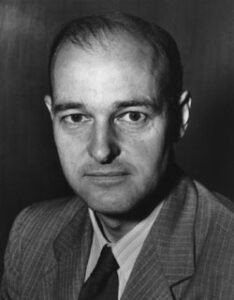The “Long Telegram” was a message sent by George F. Kennan, then the U.S. Ambassador to the Soviet Union, to the U.S. State Department in February 1946. It was a detailed analysis of the Soviet Union’s foreign policy and its motivations, and it had a profound impact on the U.S. government’s understanding of the Soviet Union and the Cold War.
In the telegram, Kennan argued that the Soviet Union’s actions were driven by a deep-seated insecurity and a belief in the inevitability of conflict with capitalist countries. He argued that the Soviet Union saw the U.S. as its main enemy and that it would use all means at its disposal to spread its ideology and undermine the U.S. and its allies. He believed that the Soviet Union’s ideology of Marxism-Leninism and its perception of the world as inherently hostile to its survival made it a formidable enemy.
In the telegram, Kennan argued that the Soviet Union’s actions were driven by a deep-seated insecurity and a belief in the inevitability of conflict with capitalist countries. He argued that the Soviet Union saw the U.S. as its main enemy and that it would use all means at its disposal to spread its ideology and undermine the U.S. and its allies. He believed that the Soviet Union’s ideology of Marxism-Leninism and its perception of the world as inherently hostile to its survival made it a formidable enemy.
Kennan proposed a policy of containment as a way to counter the Soviet Union’s expansionist ambitions. He advised the U.S. to avoid direct confrontation with the Soviet Union and instead to strengthen its alliances and contain Soviet expansion through economic and political means. He suggested that the U.S. should focus on building a strong military and economic alliance with other Western countries and that it should use diplomacy and propaganda to counter Soviet influence. He also advised the U.S. to be prepared for a long-term struggle against the Soviet Union and to avoid making any agreements that would compromise its security.
The “Long Telegram” was widely read and discussed within the U.S. government, and it had a significant impact on U.S. foreign policy. It was used to justify the Truman Doctrine, which provided military and economic aid to countries threatened by communism and helped to establish the U.S. as the leader of the Western alliance during the Cold War. The Doctrine also served as the basis for the Marshall Plan, which provided economic aid to Western European countries in order to help them rebuild after World War II and to counter the spread of communism.
The ideas contained in the “Long Telegram” also played a role in the formation of the North Atlantic Treaty Organization (NATO), which was established in 1949 as a military alliance between the U.S. and several Western European countries to counter the Soviet Union’s expansionist ambitions. The formation of NATO was a clear indication of the U.S.’s commitment to containing the Soviet Union, and it served as a powerful deterrent to Soviet expansion.
Additionally, the Long Telegram was also a basis for the U.S. foreign policy of “Rollback” which aimed to roll back the spread of communism by supporting anti-communist groups, working to overthrow communist governments, and taking other measures to limit Soviet influence. This policy was the basis of the U.S. intervention in countries like Iran, Guatemala, and Cuba during the Cold War.
Kennan’s analysis of the Soviet Union’s motivations and his proposal for a policy of containment were influential in shaping U.S. foreign policy during the Cold War. His ideas were not always popular and he was often at odds with other Cold War architects like John Foster Dulles and Paul Nitze. Despite this, his ideas and views had a lasting impact on the U.S. foreign policy during the Cold War.
It’s also worth noting that Kennan later criticized the U.S. foreign policy for going beyond his initial ideas of containment and becoming more aggressive. He believed that the U.S. foreign policy went too far in its efforts to rollback communism and that it led to unnecessary conflicts and an overreliance on military force.
In conclusion, the “Long Telegram” was a seminal document in Cold War history. Written by George F. Kennan, it was a detailed analysis of the Soviet Union’s foreign policy and its motivations, and it had a profound impact on the U.S. government’s understanding of the Soviet Union and the Cold War. Kennan’s proposal for a policy of containment was influential in shaping U.S. foreign policy during the Cold War, and his ideas continue to shape the thinking of scholars, policymakers, and historians today. Although Kennan’s ideas were not always popular and he later criticized the U.S. foreign policy, his analysis and ideas on containment were a cornerstone of the U.S. strategy in the Cold War, that helped to prevent a direct confrontation between the two superpowers and ultimately ended the Cold War.
You can read George Kennan’s actual message, known as “Long Telegram”, in full here


George F. Kennan was an American diplomat and historian who served as the U.S. Ambassador to the Soviet Union from 1952 to 1953. He is best known for his role in shaping U.S. foreign policy during the Cold War, particularly for his ideas on containment of the Soviet Union. He wrote the famous “Long Telegram” in 1946, which was a message sent to the U.S. State Department from the U.S. Embassy in Moscow. In the telegram, Kennan argued that the Soviet Union’s actions were driven by a deep-seated insecurity and that the best way to deal with the Soviet threat was through a policy of containment. His ideas on containment were influential in shaping U.S. foreign policy during the Cold War and his analysis and ideas on containment were a cornerstone of the U.S. strategy in the Cold War that helped to prevent a direct confrontation between the two superpowers and ultimately ended the Cold War.


